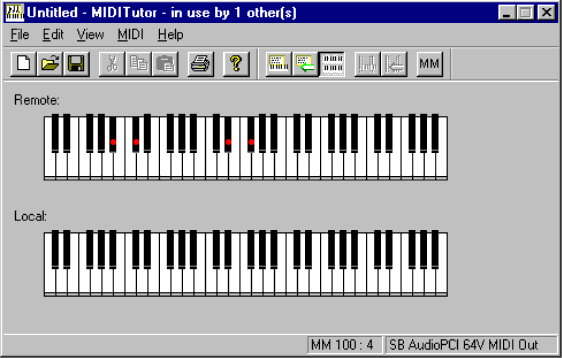
The graphical user interface of an early version of the program
This NetMeeting tool was made in the autumn 1998 in an attempt to enable keyboard based musicianship and pedagogy over the Internet. NetMeeting showed potential for realtime multimedia collaboration. Although the platform was a rather complex conglomeration of various conferencing technologies the level of documentation and publication of the programming interfaces encouraged into a development effort.
The prototype was tested in a novel fashion. Experiments were conducted with other NetMeeting users contacted through user directories offered by regular Internet Locator Servers of the day. Once the connection was established the author presented himself and offered the counterpart the possibility of participating in an Internet collaboration experiment with the new tool. Then the software was downloaded as a NetMeeting file transfer. At the end of the transfer the application was started at the receiving endpoint.

The encounters were a quite pleasing experience for both parties, as viruses had not yet arrived on the Internet stage. Since the undertaking was evaluated in positive terms, it seemed that NetMeeting could be a way of sharing computer resources and thus enabling ones own equipment. For example, it turned out that many of the users were unaware of the fact that they had a synthesizer built into their computer.
A real breakthrough took place when meeting with Austrian Danielle. She was sitting in an Internet Café in Vienna. When confronted with the idea of participating in an demonstration of MIDI over NetMeeting, she responded by saying that she would bring a keyboard of her own. After a few minutes the two members of the MIDI Combo were playing together a Strauss valse. "Wunderbar!" was the next exclamation in the NetMeeting Chat.
MIDI Combo is a collaborative application which is built by utilizing the NetMeeting 2.x Application Programming Interface and user interface style recommendations. It was meant to become a standard tool for collaborative music distance education.
The main view presents two keyboards displaying outgoing and incoming key events as animated keys on a local and a remote keyboard. Both the computer keyboard and the graphical one can be used to generate archaic virtual keyboard input. The user selects an individual MIDI channel that doesn't collide with those of the other members of the meeting. Then the players select their General MIDI sounds.
The program gives access to the system's MIDI input device configuration. It also has a MIDI message dump facility, which is useful in situations where the configuration has to be debugged. Similarly, incoming MIDI messages can be monitored in a NM data message view. In addition, a simple metronome can be triggered by one of the participating parties.
In the spring of 1999 a demonstration session was organized to test the conditions of synchronized musicianship in a network situation. Two of the musicians played in the same Local Area Network and one was participating through an ISDN dial-up connection. The sounds, which are of course essentially better than the SoundBlaster sounds of the day, were produced by utilizing a Roland SoundCanvas module.
The piece to played together was Antonio Carlos Jobim's "Samba de uma Nota Só". It was estimated be rhythmically intricate enough for the situation. Jasse Varpama played synthesizer keyboard, Matti Ruippo a synthesizer keyboard base and Aarne Himberg synthesizer percussion (Roland Octapad). Below a short excerpt of the recording is being presented:
The MIDI NetMeeting tool has been used in a number of demonstration situations, but especially as a supplementary aid in data conference based music training. Matti Ruippo has carried out courses in arrangement, ear training and harmony where he has utilized MIDI Combo in various degrees. Much of this work took place in the Music Education Online project (MOVE) pilot framework which established in Kuhmo and Kuopio. Working under the regional development project of the Sibelius Academy's Kuopio Department and the International Centre Chamber Music in Kuhmo, Ruippo constructed new content for realtime music courses in a network setting.
Research and development efforts related to the use of MIDI Combo as a distance learning aid has been described in a number of conference papers and reports including:
When the MIDI Combo took off, NetMeeting was still an innocent collaborative platform utilized by friendly Internet explorers. By the year 2000 a number of issues had turned up, starting with problems related to the NetMeeting architecture itself.
After the NetMeeting 3.0 release the use of the MIDI software had been limited to one-way IP use and ensemble playing over ISDN. Data communication overhead seemed to increase and firewall arrangements made it difficult to create problem free NetMeeting sessions.
ISDN was found to be an easy way of constructing a hassle free learning situation. In a multipoint setting where participants were attached to the same dial-up server, a satisfactory situation could still be constructed without too much effort. By switched connections over telecommunication lines secure data communication with quick response times could still be achieved.
MIDI Combo is experiencing a revival, now in a new setting, when used as a way of creating video conference content. The original machinery has been modularized. Now, any desired number of participants can be catered for, as keyboards can be generated in many sizes and with any desired number of keys.
Accordingly, modularization of other aspects of the software has provided the opportunity to tailor many kinds of supplementary functionality catering for various needs in music net education. The MIDI VC Assistant is one of the tools created by utilizing this flexibility.
— Ph. Donner